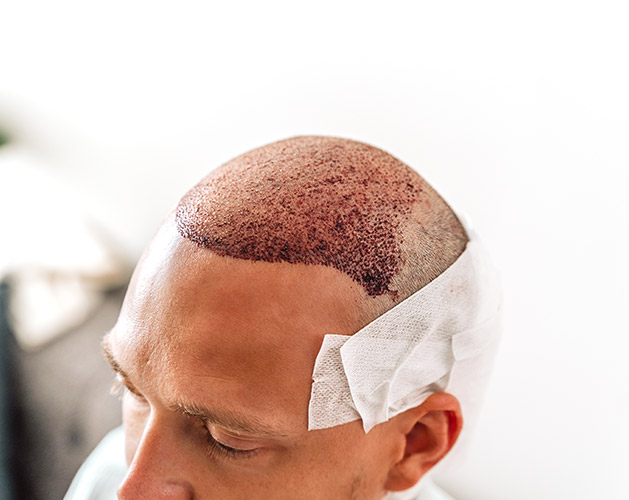
Do All Grafts Survive After Hair Transplant?
Hair transplantation is a quite popular hair restoration method for effective, long-lasting and natural results. While this invasive method can provide impressive results, one of the key concerns for both patients and surgeons is the survival rate of the transplanted grafts. This is because not all grafts necessarily survive after a hair transplant. In such circumstances, a common question of many is how many grafts can successfully survive.
Regarding this, insights have been taken from Dr. Shilpi Bhadani, a hair transplant expert at SB Trichology. She is also a leading expert in using Hair Art, a minimally Hair Transplant Technique in Gurgaon. This technique provides painless, scar-free natural and permanent results with no downtime. By incorporating vital facts of this technique to this article, we are going to discuss the various aspects that determine graft survival and provide insights into what patients can expect.
First Let’s Understand The Hair Growth Cycle
To understand graft survival, it is essential to learn about the natural hair growth cycle first. Usually, human hair goes through several phases, including:
- Anagen Phase: This is the active growth phase where hair is actively growing from the hair follicle. It can last for several years.
- Catagen Phase: In this transitional phase, the hair stops growing and detaches from the follicle. This phase is relatively short, lasting a few weeks.
- Telogen Phase: During the telogen phase, hair remains dormant. It’s the resting phase and can last for several months.
- Exogen Phase: This is the phase when hair naturally sheds.
The natural hair growth cycle varies from one person to another. When performing a hair transplant, surgeons aim to take hair follicles from the donor area (typically the back or sides of the head) in the anagen phase.
These follicles are considered the most robust and likely to survive the transplantation process. However, even with the best practices and careful selection of grafts, not all transplanted hair will necessarily survive due to various factors.
Factors Influencing Graft Survival
There are several factors influencing the survival of grafts after a hair transplant. Some are are as follows:
- Technique of Hair Transplantation
FUE (Follicular Unit Extraction) is a commonly popular hair transplant technique. In this technique follicle grafts, instead of strips, are used to extract from the donor area. After processing these grafts in the lab, these are used to implant on the bald area of the scalp.
Minimal scarring, pain, falling of some graft may occur after the treatment. Meanwhile, Hair Art is an advanced hair transplant technique with no pain, no scar and no downtime. It is 100% safe and secured treatment. The graft survival rate with Hair Art is comparatively more than FUE and traditional FUT.
- Skill and Experience of the Surgeon
In addition to hair transplant technique, the skill and experience of the surgeon play a significant role in graft survival. An experienced surgeon knows how to extract, handle, and transplant grafts carefully, so that damage can be minimised or reduced. The use of precise instruments and advanced techniques can improve graft survival rates.
- Graft Handling
To minimise the damage, grafts are needed to be handled delicately during the transplantation process. Rough or careless handling can damage grafts and reduce their chances of survival.
- Blood Supply
Furthermore, supply of the blood to the recipient area is crucial for graft survival. A well-vascularized recipient site enhances graft survival.
- Postoperative Care
Patients must adhere to their surgeon’s postoperative care guidelines. This includes staying away from vigorous activities, keeping your hands away from the grafts, and taking any prescribed medications. For transplant survival, proper postoperative care is crucial.
- Graft Quality
The grafts’ quality is very important. The chance of survival increases with graft thickness and health. During the harvesting process, surgeons frequently give top priority to choosing the best grafts.
- Individual Variation
A patient’s physiology, skin condition, and capacity for healing are only a few examples of personal characteristics that can affect transplant survival. Some folks are just more conducive to graft survival.
- Donor Area
The donor area’s condition and the quality of hair follicles can affect graft survival. If the donor area has experienced significant hair loss or damage, the transplanted grafts may be less robust.
- Environmental Factors
Environmental factors, such as humidity and temperature in the operating room, can influence graft survival. Optimal conditions during the transplant procedure are essential.
- Complications
In some cases, complications like infection or inflammation can affect graft survival. Timely recognition and treatment of these issues are vital to minimise their impact.
- Graft Density
The density of graft placement also plays a role in graft survival. Too much crowding of grafts in a small area can reduce blood supply and increase the risk of graft loss.
- Immune Response
The recipient’s immune response can affect graft survival. The body’s immune system may treat the transplanted grafts as foreign objects, leading to graft rejection. To minimise this risk, surgeons may prescribe immunosuppressive medications.
What is the Graft Survival Rate?
Despite the fact that hair transplant surgeries can be very successful, the ability to achieve a 100% graft survival rate is uncommon. Indeed, it happens more frequently than not for some grafts to die during the transplant procedure. Despite the fact that the actual rate can vary from patient to patient and procedure to treatment, surgeons strive for the maximum feasible survival rate.
The average graft survival rate typically ranges from 90% to 95%. As a result, 5% to 10% of the transplanted grafts on average may not fully survive or may grow slowly. Nevertheless, it’s crucial to realise that even if some grafts do not survive, the surgery can still result in a noticeable improvement in hair density and look.
Dealing with Grafts That Don’t Survive
If some of the transplanted grafts do not survive, it’s important not to be discouraged. The surgeon typically plans for some level of graft loss when designing the transplant, and the procedure is usually structured to ensure that the final result appears natural and aesthetically pleasing. In most cases, patients can undergo additional procedures to address any areas that may require further grafts.
Patients should also be patient, as the transplanted hair can take several months to fully grow and mature. Grafts that initially appear to be lost may sometimes begin to grow at a later stage. Surgeons often recommend waiting for at least 12 months before assessing the final results of the transplant.
Conclusion
Hair transplant procedures have come a long way in delivering impressive results for individuals dealing with hair loss. While not all grafts survive after a hair transplant, the combination of skilled surgeons, careful graft handling, and proper postoperative care can significantly enhance graft survival rates.
Understanding the factors that influence graft survival and managing expectations is important for individuals considering hair transplantation. The goal of a successful hair transplant is to provide a natural and long-lasting solution to hair loss, and even with some graft loss, it can achieve this effectively. To get precise more detail, you are advised to schedule a consultation with a medical professional and expert like Dr. Shilpi Bhadani, the Best Hair Transplant Surgeon in Gurgaon.
You can visit her at SB Trichology and consult about the best technique for maximum hair graft survival rate and other hair loss control and restoration options in detail.



